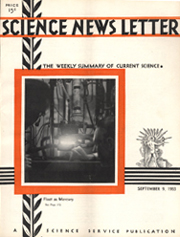From the September 9, 1933, issue

FLEET AS MERCURY
The laboratory has yielded a photograph of striking beauty showing Dr. Joseph Slepian and Leon R. Ludwig, Westinghouse engineers, examining a product of their research.
They have developed a new method of controlling mercury arc devices which is said to be more positive and many times faster in action than methods now used. The arc can be started 60 times a second at any point on the voltage wave, and, since there is no grid to be protected from heating but merely a carborundum-pencil dipping in the mercury pool, large currents can be controlled as easily as small ones.
CENTRIFUGAL ANALYSIS OF BLOOD INDICATES SPECIES RELATIONS
Using centrifugal force some four hundred thousand times the force of gravity to study the relationship of animals is the latest achievement of Dr. Theodore Svedberg, of the University of Uppsala, Sweden. In a lecture at the Woods Hole Marine Biological Laboratory, he described the application of this method to studies of blood of various animals.
The carriers of oxygen in the blood are colored substances called blood pigments. They are different in different animals, possessing differing molecular weights and structures. Therefore, if shaken up with a water solution they tend to fall to the bottom at different rates. To study these different rates at times short enough to be measurable it is necessary, however, to use forces that greatly exceed the force of gravity.
Dr. Svedberg has managed to produce this force by means of what is known as the ultra-centrifuge, a cell that holds the liquid to be tested, and is revolved at the terrific speed of 75,000 rotations per minute. To reduce friction it is necessary to have the entire rotating part of the apparatus in an atmosphere of pure nitrogen at a pressure about one-thirtieth that of the atmosphere.
VITAMIN C SYNTHESIZED BY SWISS CHEMIST
Vitamin C, the scurvy-preventing substance occurring naturally in oranges, lemons and many green vegetables, has been prepared synthetically by Dr. T. Reichstein of the Polytechnic Institute of Zürich, Switzerland. With his two collaborators, A. Grüssner and R. Oppenauer, Dr. Reichstein announces in a communication to Nature, that they have succeeded in obtaining pure crystals of 1-ascorbic acid, the highly active anti-scorbutic substance considered to be identical with vitamin C.







